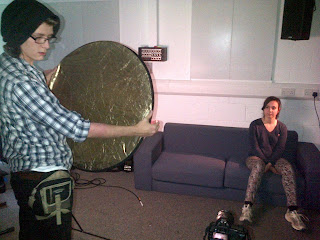By pressing 'Track Camera' it tracks various random points in your video and essentially creates a 3D space for you to add objects or text that will stay in a fixed position within the motion of your video, giving the impression that they are at one with the raw footage. So I added text to one of the track points:
 |
| The 'Bullseye' tool, which you can alter depending on how grounded you want your text to be within the video |
 |
| A hell of a lot of rotating and altering on the x, y and z axis eventually gave the impression that the text was standing upright on the ground as the camera tracked out |
After cutting out the background and trying to key frame the image in after effects I ran into a problem; key framing requires manually animating the image and the result was that as the sofa shot moved forwards it was in no way smooth. As the video played, the shot slowed down jarringly instead of smoothly slowing down and coming to a standstill. To combat this I realised that After Effects had to have some kind of graph based key framing which, thankfully, they did. Much like applying a curve tool effect in Photoshop, the way the key frames were positioned had to curve smoothly:
After applying this particular effect, the sofa shot was smooth and it finally began to slightly resemble the finished shot in Scott Pilgrim. Much more to do, such as applying the camera track to the sofa shot (which proved insanely difficult) but thats another blog post for another time. See y'all soon.













